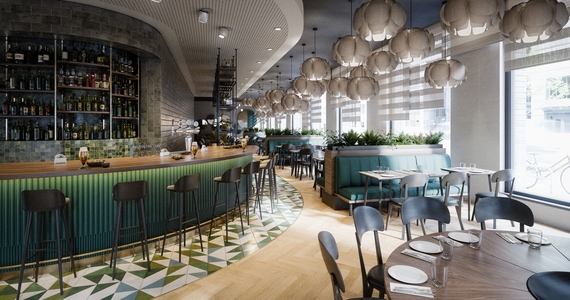Why Dining at Local Restaurants Supports Your Community and Delights Your Preference Buds
Eating at regional dining establishments supplies more than just a dish; it offers as a vital element in nurturing community vitality and financial strength. What might this suggest for the future of local dining and area connection?
Economic Impact of Local Dining

The economic influence of local eating expands much past the restaurant itself, influencing a vast array of industries within the neighborhood. Regional restaurants play a critical duty in promoting financial development by creating jobs, supporting local distributors, and adding to local earnings. When customers select to eat at regional establishments, they help sustain employment for chefs, servers, and maintenance staff, thus boosting the regional task market.
Additionally, regional restaurants frequently resource active ingredients from neighboring farms and producers, cultivating a durable supply chain that profits different agricultural sectors. This technique not only sustains regional economic climates however also urges lasting farming methods. In addition, the sales tax generated from these dining establishments contributes to crucial public solutions, such as education and infrastructure, which additionally boosts neighborhood quality of life.
Moreover, local eating establishments often cultivate a sense of area, drawing in citizens and visitors alike, which can lead to boosted foot traffic in bordering companies. This interconnectivity amongst regional business boosts economic durability, developing a lively and sustainable community environment. Fundamentally, the assistance of regional eating is an investment in the wider financial wellness of the location, promoting development and sustainability for future generations.
Unique Cooking Experiences

Additionally, lots of local facilities welcome farm-to-table techniques, highlighting the relevance of seasonal fruit and vegetables. Diners can relish the freshness of active ingredients sourced from nearby ranches, which not only improves taste yet also promotes a connection to the neighborhood landscape. This commitment to high quality and region sets the stage for distinctive cooking experiences that are often missing in chain dining establishments.
In addition, local chefs frequently experiment with fusion food, mixing diverse cooking practices to develop amazing new meals. Such advancement not only tantalizes the palate but additionally encourages daring eating, welcoming customers to widen their cooking perspectives. Engaging with local restaurants enables diners to take pleasure in dishes that are not almost food, however about the creativity and enthusiasm that define the cooking globe, making every dining experience really special and wonderful.
Strengthening Area Bonds
Eating at local restaurants plays a critical role in reinforcing neighborhood bonds by fostering links amongst residents. These establishments function as vital meeting place where individuals can participate in significant conversations, share experiences, and develop long-term memories. As patrons constant the exact same local places, they cultivate a feeling of familiarity and friendship, strengthening social ties within the area.
Furthermore, neighborhood dining establishments usually show the one-of-a-kind cultural textile of their areas, showcasing regional practices and culinary heritage. This event of local culture not just improves area identity however likewise urges citizens to take pride in their surroundings. By taking part in the local dining site scene, individuals add to a common story that binds them together.
Area events organized at restaurants, such as open mic evenings, fundraising events, or food festivals, additionally enhance these links. They offer chances for cooperation and engagement amongst diverse teams, fostering inclusivity and understanding. As locals gather to sustain local companies, they all at once sustain each other, creating an interconnected network that enhances the community's durability.
In significance, dining at local restaurants is not simply concerning food; it is an improving experience that strengthens community bonds and cultivates a lively, united local society.
Supporting Neighborhood Farmers and Manufacturers

This technique minimizes transport costs and emissions, promoting ecological sustainability while also boosting the flavor and high quality of the recipes offered. Seasonal menus, which highlight local produce, permit dining establishments to use unique culinary experiences that show the region's farming bounty.
Furthermore, supporting local farmers helps protect standard farming practices and motivates biodiversity. It equips small-scale producers, allowing them to grow in a progressively industrialized food system. As neighborhood dining establishments pick to companion with these farmers, they help maintain a vivid farming community, ensuring that regional food systems stay resilient.
Essentially, dining at neighborhood restaurants is not just concerning appreciating a dish; it is an investment in the local economy and an affirmation of sustainable methods. By picking neighborhood, diners play an important duty in supporting their neighborhoods and supporting the dedicated individuals who cultivate their food.
Protecting Neighborhood Society and Heritage
Rooted in the customs of their areas, regional restaurants work as important custodians of cultural heritage. By showcasing regional active ingredients and typical food about his preparation techniques, these facilities preserve the distinctive flavors and cooking practices that define neighborhood identification. Each dish narrates, mirroring historical impacts and cultural narratives that have shaped the area over generations.
Additionally, local restaurants commonly champion classic recipes passed down through households, making certain that distinct cultural methods remain to life. This not only educates patrons about the neighborhood's heritage however also fosters a feeling of satisfaction and belonging amongst locals. The feel, décor, and also music in these facilities typically resemble the local culture, giving an alternative experience that transcends simple dining.
Furthermore, neighborhood dining establishments add to the preservation of language and dialects, as food selections and discussions frequently integrate neighborhood vernacular. By joining community occasions and events, these dining establishments reinforce social bonds and promote cultural exchange. Fundamentally, dining at neighborhood dining establishments is not simply a cooking experience; moved here it is an opportunity to engage with and sustain the rich tapestry of regional culture and heritage, guaranteeing its continuity for future generations.
Verdict
